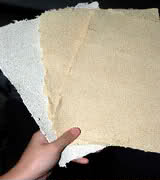Since its introduction into the country in 2005, sweet sorghum (Sorghum bicolor L. Moench) has become an important crop for research and development (R&D) given its potential as a feedstock for bio-ethanol production. Aside from being a biofuel source, sweet sorghum was further discovered for its other equally important uses-food for humans, feeds and forage for animals, and environment-friendly soil enhancer (bio-organic fertilizer). The list of benefits doesn’t seem to end as researchers continue to discover valuable uses for this so-called, “smart crop”.

One of its most recently found uses is in the handmade paper industry wherein sweet sorghum was found to be an effective fiber source for papermaking. And since this technology uses a nonwood source, it saves trees therefore reducing the need for non-sustainable clear-cutting. It also emits less green house gasses (GHGs) because nonwood source contain less lignin (glues or sugars in all plant matter) resulting in less chemicals and/or energy demands for pulping.
The development of this technology was funded by the Bureau of Agricultural Research (BAR) and was implemented by researchers, Cecilia B. Mangabat and Jouel B. Taggueg, of the Isabela State University (ISU) in Cabagan, Isabela wherein sweet sorghum bagasse was used as the main fiber source for papermaking.
Bagasse is the pulp or dry refuse left after the juice is extracted from sweet sorghum stalks during the process of producing ethanol and other sweet sorghum products. They are usually treated as farm waste in sweet sorghum plantations growing the crop for biofuel production.
Suitable sweet sorghum variety for papermaking
According to Mangabat and Taggueg, generally, all cellulosic materials can be used in paper production but the properties of paper products vary depending on the morphological characteristics of the fibers used. The length, cell wall thickness, and lumen diameter of the fiber used can greatly affect the quality of handmade paper that will be produced.
To specifically determine what varieties of sweet sorghum are suitable raw materials for pulp and paper production, the ISU researchers investigated the suitability of five varieties of sweet sorghum. The five varieties, namely: ICSV700, NTJ2, SPV422, ICSR93024, and ICSV93046 were analyzed based on the morphological characteristics of their stillage.
The fiber length is an important characteristic as it affects the paper’s tearing strength; the longer the fiber the higher the tearing strength of the paper. In the study of Mangabat and Taggueg, all varieties showed moderately short fibers with cell wall thickness ranging from moderately thin to very thin. But the length of sweet sorghum fibers is comparable to that of eucalyptus species and paper mulberry that are suitable for papermaking.
Another important characteristic is the lumen diameter. Fibers with wide lumen are favored for papermaking because they collapse easily and form papers which are flexible and with high tensile strength.
The cell wall thickness is also an important fiber characteristic. Thin-walled fibers are preferred since they produce dense and well formed sheets. Meanwhile, thick-walled fibers produce papers which are bulky and coarse.
Given these characteristics as bases, three varieties of sweet sorghum, NTJ2, SPV422, and ICSR93024 were found suitable as raw materials for pulp and paper production.
13 Easy steps to producing handmade papermaking
Mangabat and Taggueg developed 13 easy steps in making handmade paper from sweet sorghum bagasse.
1. collect sweet sorghum bagasse
2. remove the soft inner portion of the bagasse (referred to as “depithing”)
3. cut the bagasse into one-inch lengths
4. dissolve sodium hydroxide (NaOH) flakes in water (200 grams of NaOH for every 1 kilogram of chopped bagasse)
5. cook the bagasse in the NaOH solution for at least 4 hours to soften the fibers
6. wash the cooked bagasse thoroughly until the slippery texture is removed
7. pound/blend the softened fibers until desired texture is obtained
8. bleach pulp using sodium hypochlorite (pulp can be dyed to produce different colors of handmade paper)
9. prepare the pulp slurry by distributing the beaten pulp evenly into a basin of water (don’t add more water if thin paper is preferred)
10. dip the mould and deckle into the basin of slurry (tilt the mould and deckle back and forth until water is drained through the screen)
11. remove excess water using sponge
12. separate the mould from the deckle (cover the formed sheet with cloth, turn it upside down and then separate the mould from the sheet)
13. transfer the sheet to formica/ plywood/ glass panel (remove cloth and dry the sheet under room temperature)
This article was based on a BAR-funded study titled, “Suitability of Sweet Sorghum Varieties for Pulp and Paper based on Fiber Morphology” by Cecilia B. Mangabat and Jouel B. Taggueg of the Isabela State University, Cabagan, Isabela.
Fore more information please contact, the lead researchers, Cecilia B. Mangabat and Jouel B. Taggueg, through their email addresses: cecillemangabat@yahoo.com and jbt121271@yahoo.com
Source: Rita T. dela Cruz- BAR Chronicle bar.gov.ph




Recent Comments